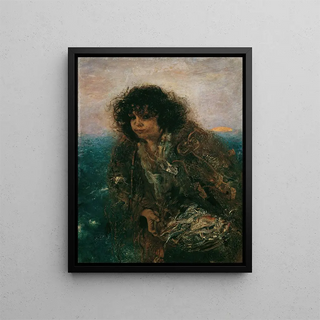Art print | L'enfant du pêcheur italien - Anton Romako


View from behind

Frame (optional)
The artwork "L'enfant du pêcheur italien" by Anton Romako is a true homage to innocence and the beauty of childhood, captured in a moment of grace. This painting, imbued with emotion, transports the viewer into a world where the simplicity of everyday life blends with unparalleled artistic depth. Contemplating this piece, one immediately feels a connection with the subject—a young child whose delicate features and pensive expression invite reflection on the fragility of existence. The soft light bathing the scene emphasizes the tenderness of this frozen moment in time, making this work a genuine treasure of art.
Style and uniqueness of the work
Anton Romako's style stands out for its ability to combine realism and romanticism, creating an atmosphere that is both intimate and universal. In "L'enfant du pêcheur italien," warm, earthy colors evoke Mediterranean landscapes while highlighting the emotional richness of the subject. The artist masterfully controls the play of light and shadow, giving the scene an almost three-dimensional quality. Every brushstroke seems charged with life, and every carefully crafted detail contributes to the harmony of the whole. Romako thus manages to capture not only the physical appearance of his model but also the very essence of their being. This painting does not merely depict a child; it evokes dreams, hopes, and struggles of a young human being, offering a poignant reflection on the human condition.
The artist and his influence
Anton Romako, born in 1832 in Vienna, was an artist whose career was marked by an unceasing quest for beauty and truth. Influenced by the great masters of painting, he developed a personal style distinguished by sensitivity and a humanist approach. Romako was not afraid to explore various themes, but it is in the representation of childhood that he found an inexhaustible source of inspiration. His work had a significant impact on his contemporaries and continues to influence many artists today. By integrating elements of realism and romanticism, he manages to create

Matte finish

View from behind

Frame (optional)
The artwork "L'enfant du pêcheur italien" by Anton Romako is a true homage to innocence and the beauty of childhood, captured in a moment of grace. This painting, imbued with emotion, transports the viewer into a world where the simplicity of everyday life blends with unparalleled artistic depth. Contemplating this piece, one immediately feels a connection with the subject—a young child whose delicate features and pensive expression invite reflection on the fragility of existence. The soft light bathing the scene emphasizes the tenderness of this frozen moment in time, making this work a genuine treasure of art.
Style and uniqueness of the work
Anton Romako's style stands out for its ability to combine realism and romanticism, creating an atmosphere that is both intimate and universal. In "L'enfant du pêcheur italien," warm, earthy colors evoke Mediterranean landscapes while highlighting the emotional richness of the subject. The artist masterfully controls the play of light and shadow, giving the scene an almost three-dimensional quality. Every brushstroke seems charged with life, and every carefully crafted detail contributes to the harmony of the whole. Romako thus manages to capture not only the physical appearance of his model but also the very essence of their being. This painting does not merely depict a child; it evokes dreams, hopes, and struggles of a young human being, offering a poignant reflection on the human condition.
The artist and his influence
Anton Romako, born in 1832 in Vienna, was an artist whose career was marked by an unceasing quest for beauty and truth. Influenced by the great masters of painting, he developed a personal style distinguished by sensitivity and a humanist approach. Romako was not afraid to explore various themes, but it is in the representation of childhood that he found an inexhaustible source of inspiration. His work had a significant impact on his contemporaries and continues to influence many artists today. By integrating elements of realism and romanticism, he manages to create






